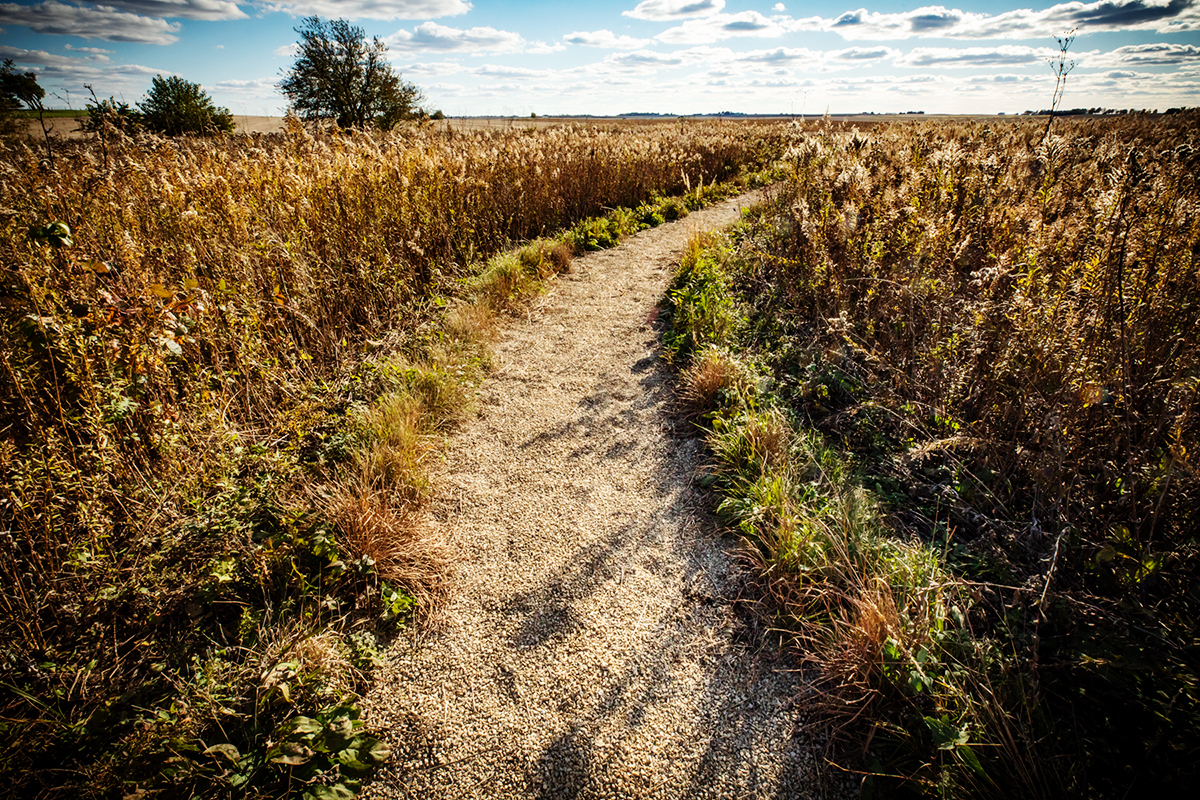
A 6-foot wide gravel path snakes through Fred and Nancy Delcomyn's backyard prairie, seen here in early November.
Photo by L. Brian Stauffer

The dried seed heads of wild bergamot in November.
Photo by L. Brian Stauffer
OUTSIDE URBANA, Ill. – Early November may not be an optimal time to visit a tallgrass prairie in central Illinois. But if you know what to look for, as my two guides do, it's as good a time as any.
Despite recent heavy rains, the prairie looks as dry as a skull. Grass and flower stalks rattle in the cold breeze, and each plant appears to sport its own special array of desiccated seeds, leaves and flower heads. The ground is still damp but the tops of the plants are crispy.

Fred Delcomyn, left, and James Ellis are the authors of "A Backyard Prairie," a book describing the process of installing a new prairie on century-old farmland.
Photo by L. Brian Stauffer
I'm here with Fred Delcomyn and James Ellis, the authors of "A Backyard Prairie," a book about Fred and Nancy Delcomyn's personal project, a 3-acre swath of prairie that they began installing near their home in 2003 and have nurtured ever since.
We're on a quarter-mile path that Delcomyn mapped out on the bare ground before he and a crew from the Illinois Department of Natural Resources began seeding. According to the book, the path divides the prairie into three sections, each of which is burned once every three years. The unburned zones offer refuge for the prairie critters that flee from the flames.
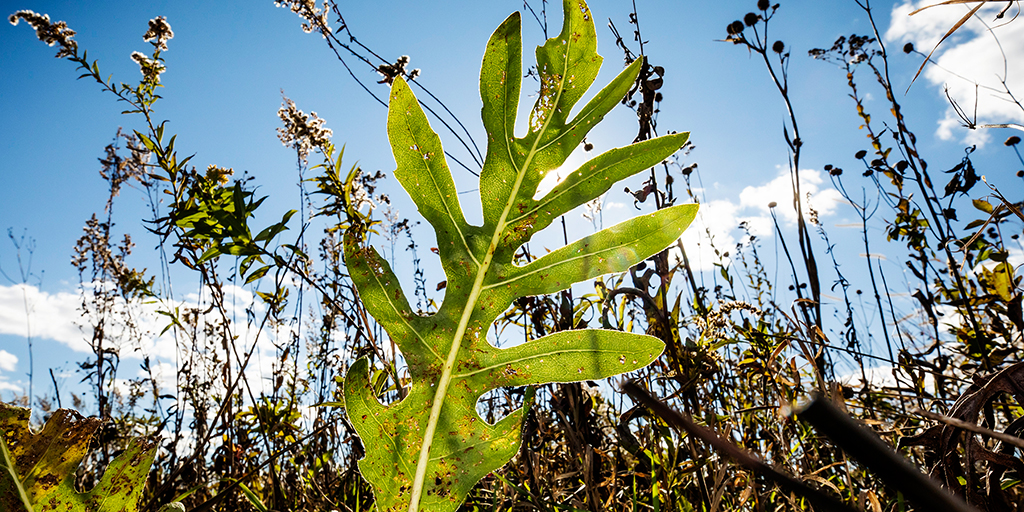
The compass plant aligns its large leaves to face east and west, allowing it to avoid scorching southern rays in summer.
Photo by L. Brian Stauffer
As we begin our exploration, Delcomyn draws my attention to a bur oak standing somewhat defiantly near the edge of the new prairie. It is only about 30 feet tall but it's the only sizable tree around, apart from a tiny woodland that buffers the house. Delcomyn tells me he planted this tree when the prairie was first installed.
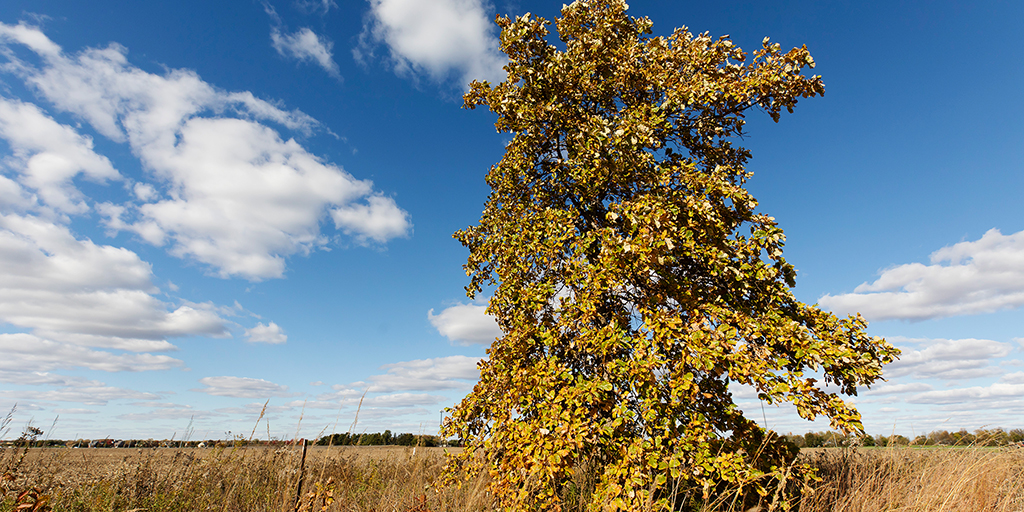
The Delcomyns' bur oak is now 30 feet tall.
Photo by L. Brian Stauffer
"This seedling over here, that's its offspring," he says, pointing to a thigh-high sapling that I wouldn't have noticed if he hadn't directed my attention to it.
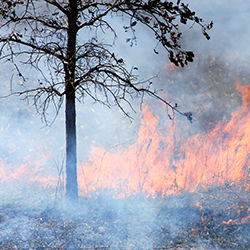
This bur oak has survived several cycles of fire since it was first planted in 2003. Bur oaks are one of only a few fire-adapted trees.
Photo by Fred Delcomyn (from "A Backyard Prairie")
I learned from the book that – unlike most trees – bur oaks can withstand the regular fires that keep the prairie a prairie.
"If a seedling is top-killed by fire, it readily resprouts from the roots," the authors write about the bur oak. To prevent the trees from becoming stunted, the team trims the grasses back and wets the area around them before burning, says Ellis, who helps out and consults on the burns, and serves as a plant-identification resource to Delcomyn when he's stumped.
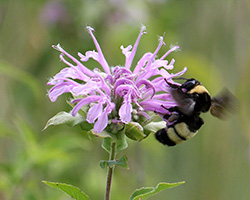
A black-and-gold bumble bee hovers while it sips nectar from the flower of wild bergamot.
Photo by Fred Delcomyn (from "A Backyard Prairie")
Beyond the edge of the prairie, we can see the stubble and silky residue of vast, recently harvested corn and soybean fields. Delcomyn and Ellis have a chapter in the book devoted to the complex history of this landscape, from the last ice age to the present. Most recently, agriculture displaced almost all native grasslands in Illinois.
"Altogether, it is estimated that about 60% (about 22 million acres) of Illinois was prairie when the first Europeans appeared on the scene," the authors write. Now, only scattered patches of restored prairie remain, with even fewer remnants of original prairie.
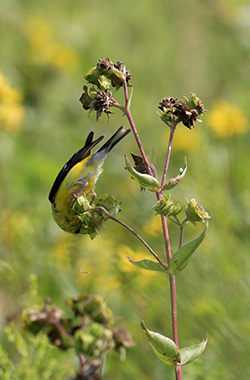
As fall approaches, an American goldfinch feasts on the seeds of rosinweed in the backyard prairie.
Photo by Fred Delcomyn (from "A Backyard Prairie")
Working to restore a prairie on century-old farmland – especially when starting from seed, as the Delcomyns did – requires plenty of patience and a lot of help. Their first task, beyond clearing and preparing the land, was the purchase of seed.
"A healthy native prairie can easily contain 150 different species of flowering plants and grasses, far too many to consider for individuals with limited resources," the authors write. The Delcomyns chose to seed wildflowers that would bloom from May to October. They also planted prairie grasses – and a few legumes, to build nitrogen into the soil.
The book describes an IDNR program, Acres for Wildlife, that supports landowners working to return their property to a more natural state. This program provided staff and equipment for the job of seeding the Delcomyns' site.
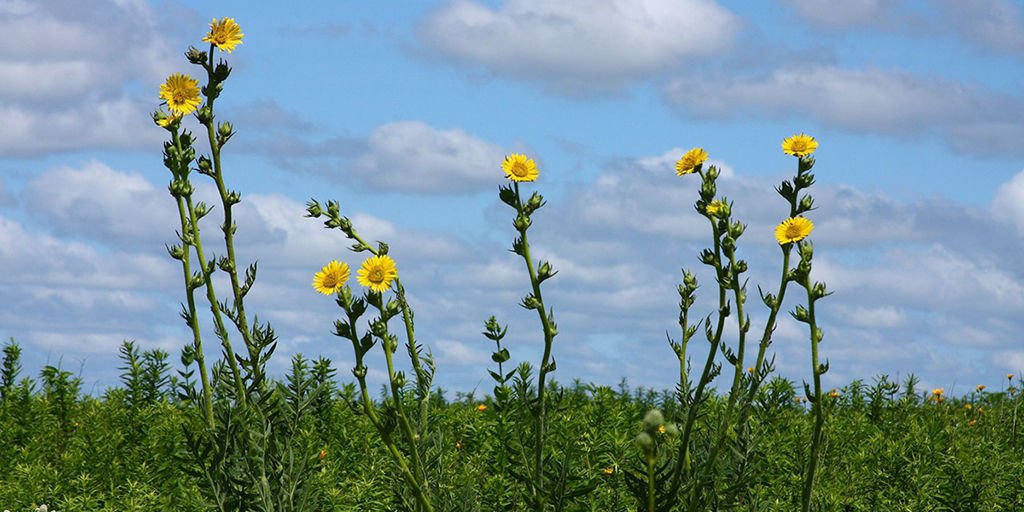
The flowering stems of compass plants tower over the backyard prairie on a summer afternoon. They can easily reach a height of 8 feet.
Photo by Fred Delcomyn (from "A Backyard Prairie")
"A Backyard Prairie" realistically describes the challenges of establishing a "new" prairie on agricultural soil. Prairie plants take time to establish themselves, as most of their early development occurs underground. The book describes the early emergence of every kind of unwanted weed, and the slow transition to a landscape dominated by prairie flowers and grasses.
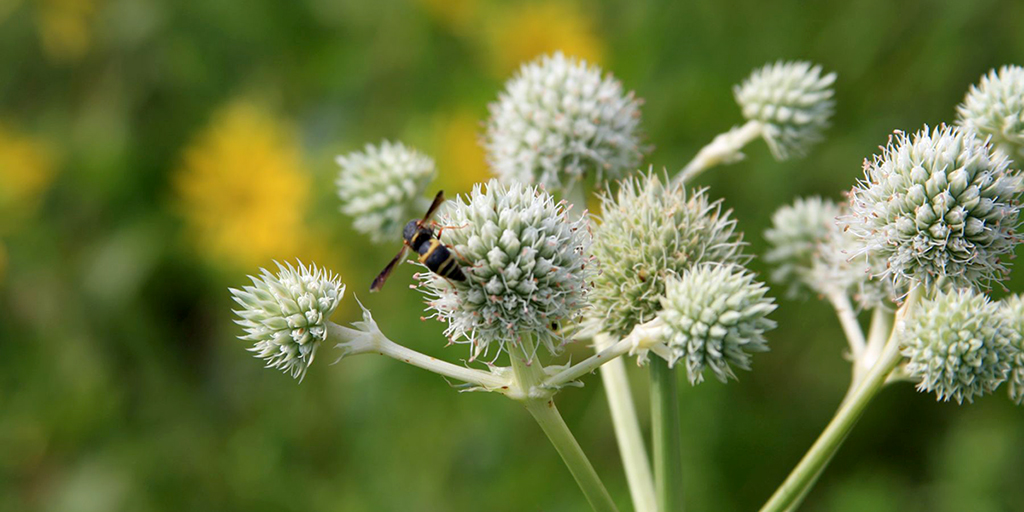
The tiny flowers of rattlesnake master form a tightly packed sphere.
Photo by Fred Delcomyn (from "A Backyard Prairie")
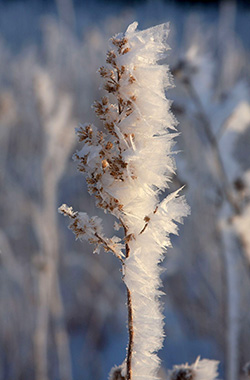
Frost covers the top of showy goldenrod after a freezing night in December.
Photo by Fred Delcomyn (from "A Backyard Prairie")
Walking through this backyard prairie with Delcomyn and Ellis – and reading their book – is like taking a natural history seminar with two experts who love the subject matter. Every plant has a story, and Ellis and Delcomyn are eager to share it. There's the compass plant, whose broad leaves capture the morning and late-day sun but avoid midday's scorching rays. And white wild indigo, which sends up lovely floral spires but is difficult to germinate from seed and is regularly attacked by weevils. There's rattlesnake master, with geometric white blooms that "look like miniature golf balls," Delcomyn says. And several types of goldenrod, a late-season bloomer that sometimes gets a little too aggressive and must be mowed.
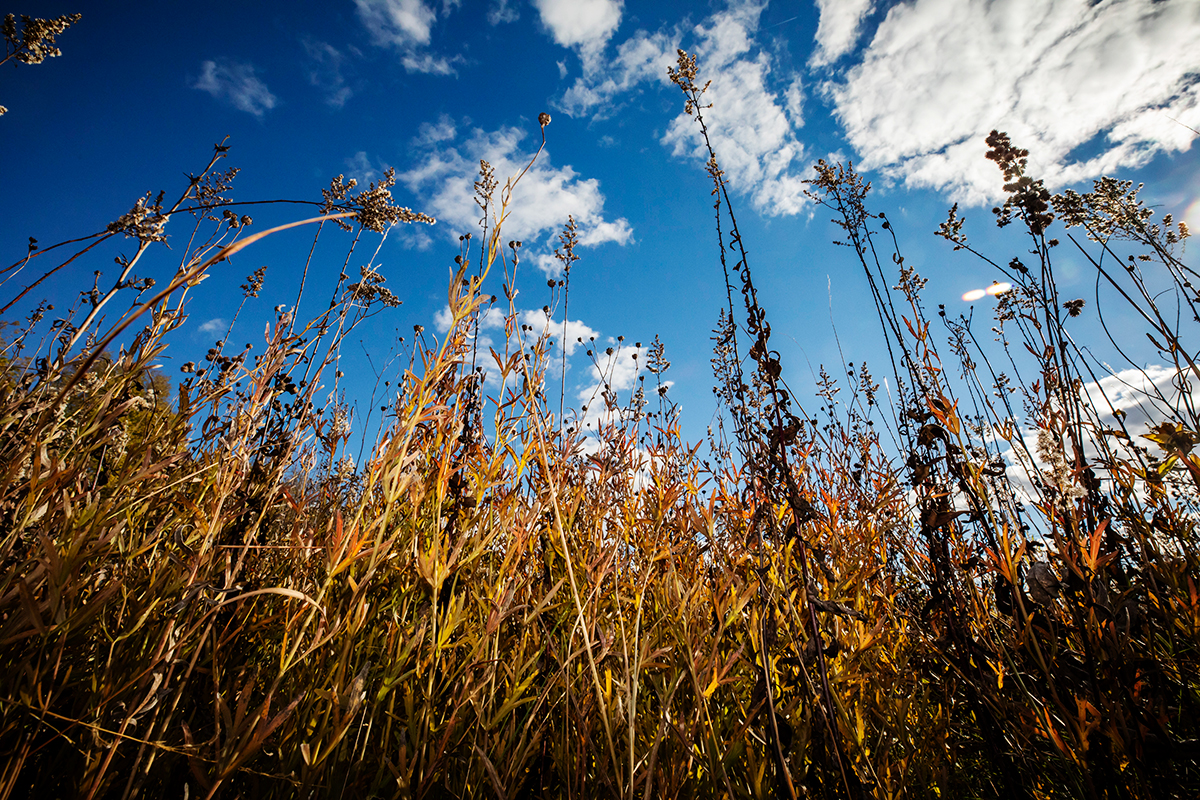
Every season has its charms. This November, the soil is damp but the plants are crispy.
Photo by L. Brian Stauffer
There also are the creatures that call this little swath of paradise home: insects and spiders, voles, coyotes, rabbits and a variety of birds, each making use of the prairie's riches and contributing to the life of this ecosystem. Most of them are stealthy, but the Delcomyns' regular walks on the prairie path reveal some of their hidden ways. In winter, especially, the snow betrays their comings and goings with footprints and wing marks.
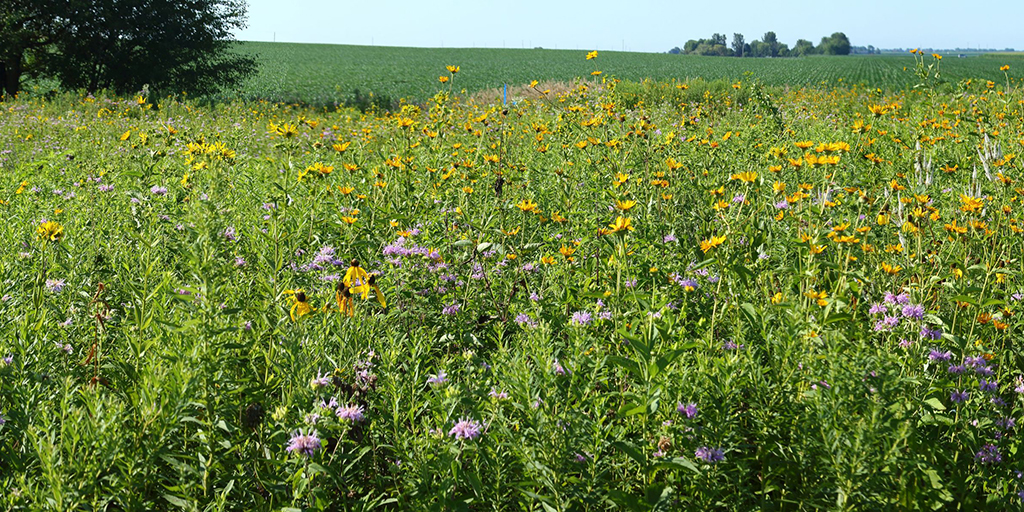
The Delcomyns' backyard prairie in full bloom in early summer. In the distance are soybean fields.
Photo by Fred Delcomyn (from "A Backyard Prairie")
"A Backyard Prairie" offers insight into installing prairie on a small-but-significant scale, adding to the prospect that these distant patches of what was once a vast flowering grassland can be reconnected – if only by wandering creatures and hopeful landowners.






